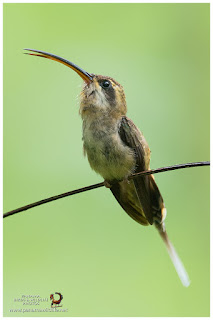After a long absence we returned to Pipeline Road to observe and photograph wildlife species. Below the results of this very short tour that took half a day.
My first find was a
Long-billed Hermit (Phaethornis longirostris) singing at his lek. The long-billed hermit is a large hummingbird that is a resident breeder from central Mexico south to northwestern Colombia, extreme western Venezuela and western Ecuador.
Males sing in leks in forest understory, and also
wiggle their long tails in display. Competitive lek singing can occupy half of the daiylight hours, the purpose of course being to attract females. The female selects the best lek singer to mate with. In Panama it's found
commonly on both slopes in lower levels of forest.

Later we found a male
Blue-black Grosbeak (Cyanocompsa cyanoides) calling his young which he was feeding. This is a species in the
Cardinalidae family, found in Belize, Bolivia, Brazil, Colombia, Costa Rica, Ecuador, French Guiana, Guatemala, Guyana, Honduras, Mexico, Nicaragua, Panama, Peru, Suriname, and Venezuela. Its natural habitats are subtropical or tropical moist lowland forests and heavily degraded former forest. In Panama it's
common on both slopes in lower levels of forest and woodland. Tends to remain in cover;
often difficult to see.
The
Checker-throated Antwren (Epinecrophylla fulviventris) is a small member of the
antbird family, resident in tropical Central and South America from northeastern Nicaragua to western Ecuador. In Panama it's
common on entire
Caribbean slope and on the Pacific slope from Panamá Oeste province eastward to Darién.
The
Hymenoptera are the third largest order of insects, comprising the sawflies,
wasps, bees and ants. Over 150,000 species are recognized, with many more remaining to be described. Hymenopterans range in size from very small to
large insects, and usually have two pairs of wings. Their mouthparts are adapted for chewing, with well-developed mandibles. Many species have further developed the mouthparts into a
lengthy proboscis, with which they can drink liquids, such as nectar. They have large compound eyes, and typically three simple eyes (ocelli).
Giant Helicopter Damselfly (Megaloprepus caerulatus) is a
damselfly of the helicopter damselflies, giant damselflies or forest giants family (
Pseudostigmatidae), found in wet and moist forests in Central and South America. It has the
greatest wingspan of any living damselfly or dragonfly, up to 19 centimeters (7.5 inches) in the largest males. Its large size and the markings on its wings make it a conspicuous species.
As an adult it feeds on orb-weaver spiders in the forest understory, which it plucks from their webs. It lays its eggs in water-filled holes in trees; males defend the larger holes as breeding territories. The young (known as naiad) is a top predator in its tree-hole habitat, feeding on tadpoles and aquatic insects, including the larvae of mosquito species that are vectors of human disease.
The adult's body is dark brown or black and has yellowish markings. The wings are
hyaline
(transparent), with a
dark blue band on the outer third. Females have a
milky-tinged patch at the tip of each wing,
while males (as pictured) of most
populations
have a lighter band just inside the dark blue one.
The
Neotropical Green Anole (
Anolis biporcatus) is a species of
Anolis lizard, native to Central America and northern South America, from Mexico to Ecuador and Venezuela.
Red-capped Manakin (Ceratopipra mentalis) - female
We also observed a Great Jacamar and lots of antwrens, Fasciated, and Black-crowned Antshrieks, Black-faced Antthrush, also other species of manakins common in the area, Blue-crowned, and Golden-collared but neither one of them colaborated for good pictures.
To finish our short tour we went to Old Gamboa Road where we found this immature Collared Forest-Falcon (Micrastur semitorquatus), the largest member of its genus. It occurs in a wide variety of tropical forested habitats from central Mexico to southern Brazil. Typically prefers humid lowland rainforest but can be found in semi-deciduous, deciduous and riparian forests in the more arid parts of its range. The species is uncommon in Panama on both slopes in lower levels of forest, and it's generally harder to see than hear.













Thanks you for sharing this unique useful information content with us. Really awesome work. keep on blogging
ReplyDeleteBest Digital Camera For Action Shots